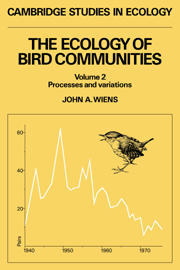Part I - Interpreting community patterns: process hypotheses
Published online by Cambridge University Press: 18 December 2009
Summary
The study of bird communities begins with the search for patterns, but rarely does it end there. A pattern, by its very existence, begs for explanation. What processes have caused it to be the way it is? The search for patterns in bird communities has usually been conducted within the framework of the MacArthurian paradigm, which focuses on interspecific competition as the major (often the only) process determining these patterns. As a consequence, patterns consistent with that view have been emphasized, even when methodological flaws render them suspect or when they cannot be distinguished from patterns that might be generated by other processes. There is thus a bias to the sorts of patterns we document and discuss. The well-worn tenets of competition theory fit comfortably over those patterns, providing explanations that are satisfying to many ecologists. Processes are inferred from patterns and then treated as demonstrated facts rather than as hypotheses awaiting tests. Unfortunately, it is considerably easier to assert the operation of a process such as competition than to test that assertion, and this has reinforced the tendency to rely on inference and assertion in process explanations.
To break away from this doctrinaire approach to interpreting community patterns, it is necessary to recognize the folly of single-factor explanations and to evaluate alternative process hypotheses. In order to test these hypotheses, however, we must consider the criteria for documenting the operation of a process with a given degree of certainty and evaluate the evidence at hand. This is my objective in the following three chapters. Because of its historical prominence, I consider competition first and then examine various other processes that may affect community patterns.
- Type
- Chapter
- Information
- The Ecology of Bird Communities , pp. 1 - 2Publisher: Cambridge University PressPrint publication year: 1989
- 1
- Cited by



